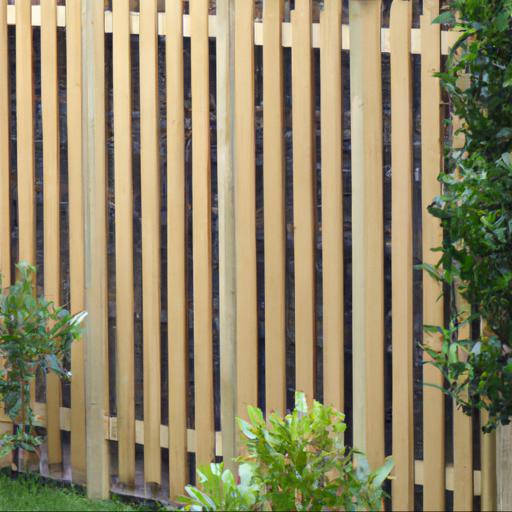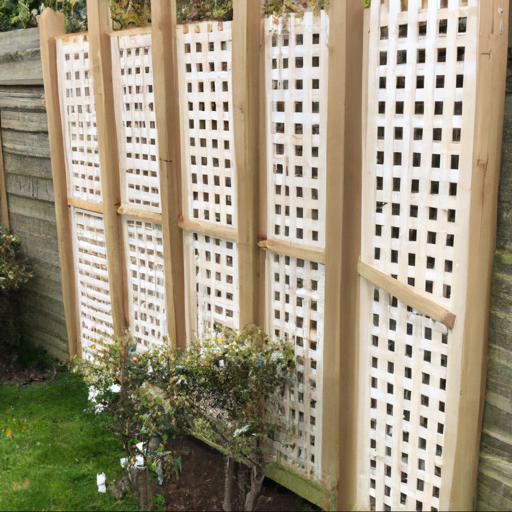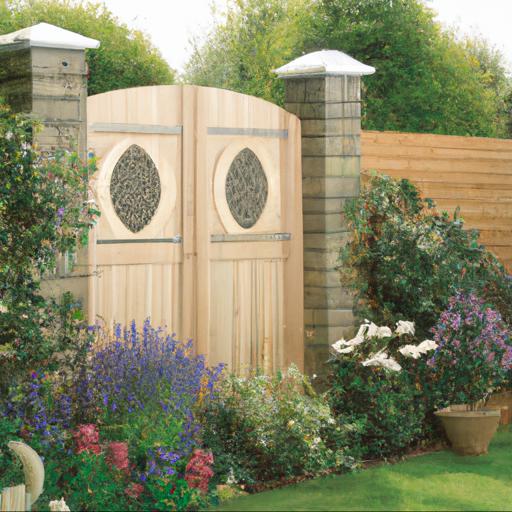Are you looking for ways to add privacy to your garden? Garden screens are a great way to add a little extra seclusion and style to your outdoor area. In this blog, we will explore six ideas for garden screens to help you find the perfect solution for your space.
From living walls to decorative lattices, you’ll find something to suit your needs and aesthetic. Read on to learn more about the different types of garden screens available.
Benefits of garden screens

As a UK garden expert, I know that garden screens bring a plethora of advantages to gardens of all shapes and sizes. Whether you’re looking to partition your outdoor space into two distinct areas or create some privacy for dining alfresco, garden screens are a great solution.
When considering garden screens, there are a number of creative options available. Six ideas for garden screens include using modern walls and fences, treillage, outdoor curtains, living walls, reed screens, or even something as simple as a trellis with climbing plants. Modern walls and fences are an excellent option when needing to block a view or defining distinct areas.
These days, there is a great variety in materials, styles, and colours, allowing gardeners to get creative with their designs. Adding a trellis to the top of a fence can extend the height, while simultaneously creating an interesting visual element.
In contrast, treillage is a more decorative choice. This style of trellis is typically more ornate compared to a traditional trellis and when set off with climbing plants and colourful blooms, can have a pronounced impact on your garden. For a more fluid look, outdoor curtains are an excellent option.
As well as providing some privacy, the sheer fabric adds an eye-catching aesthetic. Living walls bring an element of nature and vibrant wildlife to your garden. Gardening fanatics can create a kaleidoscope of colours and shapes using this style of wall.
For a low-maintenance option, reed screens are also a great choice. These are made from all-natural materials, come in a variety of heights, and can be a practical way of providing relief from strong winds.
As you can see, there are a variety of creative ways to incorporate garden screens into your garden. Each of the six ideas mentioned are an excellent way to provide some privacy, enhance the look of your garden, and create lively, useable outdoor spaces.
Types of garden screens

As UK garden experts, we know that sometimes your garden’s privacy and ambiance need a bit of a lift or a modern update. This is why adding a garden screen is a great solution to this problem!
Garden screens come in many shapes and sizes, from living walls and hedges, to solid dividers and even flexible fabric options – but with so many options available, it can be difficult for a novice gardener to choose. So, here are six great ideas for garden screens that are sure to please!
Plant a Hedge: Planting a hedge is one of the most effective ways of creating a garden screen – it’s low-maintenance and can offer a great sense of privacy. Depending on where you live, a variety of hedges are available and they come in different shapes and sizes that can be customised to fit your garden.
If you’re looking for a softer, more organic feel, Hedges such as Lavender and Rosemary can be great options, or if you’re looking for something a bit more substantial, evergreen varieties such as Thuja, Conifers and Yew will provide more of a solid barrier. Install a Wooden Divider: Wooden dividers such as fencing panels, lattices and slats can be used to partition different areas of your garden and provide both privacy and a modern touch.
Depending on your budget, you can opt for options made out of wood or composite materials that are designed to be weatherproof and last all year round with minimal maintenance.
Grow a Living Wall: Growing a living wall can not only provide a beautiful backdrop, it can also offer a great sense of privacy. This can be done by installing metal trellis, which can then be covered with creeping plants such as Ivy, Wisteria and Jasmine, so you can enjoy the flowers and greenery all year round. Alternatively, if you’re a bit more hands-on and looking for an easy-to-maintain option, consider installing a vertical garden system and fill the pockets with the plants and flowers of your choice.
Use Flexible Fabric: For a more mobile solution, flexible fabric screens are the way to go. Available in a variety of colours and designs, fabric screens can be used to temporarily partition your garden or to create a more permanent solution. They can be rolled up and stored away when not in use, making them great for those who want to add a finishing touch to their outdoor space. Create a Curtain of Plants: A DIY way of creating a garden screen can be to plant climbing plants in hanging baskets which can then be hung around your outdoor space. Not only can this provide a sleek and stylish look, but plants such as Wisteria and Morning Glory will bring fragrance and colour to your garden in the summer months. Install a Trellis: A trellis is a great way to support climbing plants and provide some extra privacy while also creating a beautiful visual texture. It’s easy to install and you can find them in a range of shapes, sizes and materials to fit your garden perfectly. No matter which garden screen you choose, we can guarantee you’ll benefit from a nice boost of privacy, ambiance and style. By selecting the best option for you, you’ll be able to enjoy your garden to the full!
How to choose the right garden screen

. It can be difficult to decide what is the best type of garden screen for your outdoor space. Whether you are looking to add extra privacy, create a stylish feature, or just block out the wind and noise from next door, there are a number of options to choose from.
In this blog post, we have compiled six ideas for garden screens that will help you find the best fit for your garden. The first thing you will want to consider is the size of the space, and the amount of coverage you need.
Smaller gardens might just need one or two screens, while larger garden can benefit from several panels or a continuous divider. If you are planning a long-term solution, such as a trellis over a fence, then you can explore more permanent options such as pressure-treated boards or lap fencing.
For gardens that require added privacy, you can choose lattice panels or decorative trellis. For example, a willow trellis can give a classical look and offer privacy and sound insulation. If a more contemporary look is required, steel screens or aluminum louvered panels are great options.
Like the willow trellis, these can be used to create a wall-effect with very low maintenance. For an eclectic feel and to quickly create a backdrop for your garden, why not incorporate a few wind spinners or a mobile?
These can provide interest and movement and have the added benefit of reflecting light. If you are looking for a way to introduce colour to your garden, you can choose pot stands, obelisks and plant supports. Or, if you would like to draw attention towards specific parts of your garden, you could use screens with patterns or motifs cut into them.
Whether you are refreshing an old garden or wanting to add structure and style to a new one, there are plenty of options available. From the natural, one-off solutions that offer character and individuality, to the industrial-style solutions, which are perfect for a modern, minimalistic look. Hopefully, this has given you some ideas for what sort of garden screen will fit your style and space best.
Six ideas for garden screens
Creating a beautiful garden is all about drawing the eye in and out, allowing the viewer to take in the true beauty of your landscaping vision. A garden screen, whether it be a metal panel, a shrub wall, or even plants on a trellis, can be an effective way to frame the look of your exteriors. Using six ideas for garden screens, you can create a unique and striking landscape that is both timeless and aesthetically pleasing.
One option you have to achieve a beautiful garden screen is with the use of a trellis. These mesh structures are both aesthetically pleasing and supportive.
They are available in a variety of designs and sizes, and can be used to support climbing plants like roses, clematis, and grapevines. The trellis can then provide a dramatic visual element, and make your garden appear even more lush and inviting.
Another idea is to utilize a planted wall. This setup consists of a collection of plants or herbs that are grown in boxed containers. These planted walls are usually used to create a secluded and private area in your garden, but they can also add beauty and a sense of calm in the space.
They can even be used to create an attractive focal point within your landscape. A third option is privacy fences. These are made from wood, metal, or a combination of both, and can be used to frame the look of your outdoor space.
Privacy fences are perfect for adding a sense of privacy, security, and wilderness to gardens, patios, pools, and more. They also provide a great way to minimize noise that may come from the outside.
If you’re feeling really adventurous, try a living wall. Living walls are basically walls filled with plants and other greenery which can be either permanent or portable. These vertical gardens must be designed carefully, but they can create the perfect secluded and peaceful area within your garden. If you prefer something more contemporary, you could opt for wall sculptures. Wall sculptures can be crafted with metal, glass, and other materials, and can come in unique shapes and sizes. With careful selection, you can find one that lends a unique look to your garden. Finally, if you’re looking for a unique and eye-catching way to frame your outdoor spaces, consider an outdoor privacy screen. These screens are constructed from wood, metal, or bamboo, and are perfect for adding a barrier between your garden and your neighbors. Many of these screens are designed in shapes that are both pleasing to the eye and effective at providing you with privacy. Using any of the six ideas for garden screens, you can create a beautiful outdoor space that is both safe and aesthetically pleasing. From trellises to privacy screens, there are plenty of possibilities which can help create the perfect outdoor sanctuary!
Final Touch
Garden screens can be used to add privacy and beauty to any outdoor space. Here are six ideas for garden screens that will help you create the perfect outdoor oasis: 1) Use potted plants to create a living wall; 2) Install a trellis with climbing plants; 3) Hang a curtain of outdoor fabric; 4) Set up a bamboo fence; 5) Incorporate a lattice fence; and 6) Create a custom fence with wood slats or pallets.
With these ideas, you can easily create a beautiful, private outdoor space.
FAQ
What materials are best for making garden screens?
The best materials for making garden screens are wood, bamboo, metal, and plastic.
How can I create a privacy screen in my garden?
One way to create a privacy screen in your garden is to plant tall, dense shrubs or trees that will block out the view from the outside. You can also use fencing, lattice, or trellis to create a more permanent barrier.
What plants are suitable for a garden screen?
Some suitable plants for a garden screen include evergreen trees and shrubs such as Leyland cypress, Thuja, and Bamboo, as well as flowering shrubs like Viburnum and Forsythia.
How do I install a garden screen?
To install a garden screen, you will need to measure the area you want to cover, purchase the appropriate materials, and assemble the screen according to the instructions. You may also need to use tools such as a drill, saw, and screws to secure the screen in place.
What are the benefits of having a garden screen?
The benefits of having a garden screen include providing privacy, blocking out noise, creating a sense of enclosure, and providing a decorative element to the garden. Additionally, garden screens can also provide shade and protection from wind.
What are some creative ways to use garden screens?
Some creative ways to use garden screens include creating a privacy wall, creating a backdrop for a seating area, creating a living wall, creating a decorative fence, and creating a windbreak.

